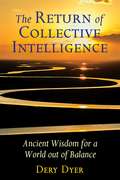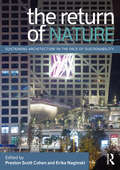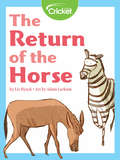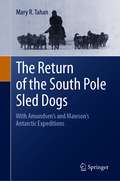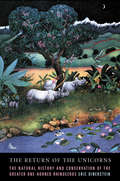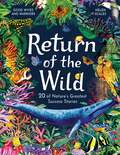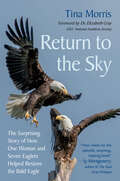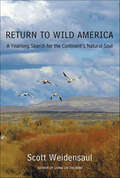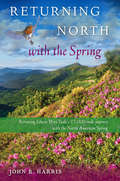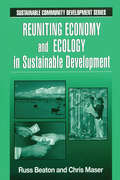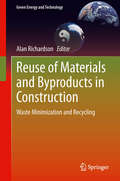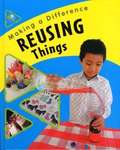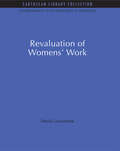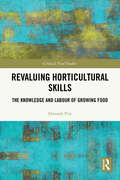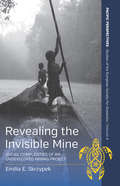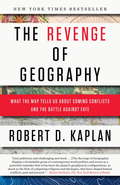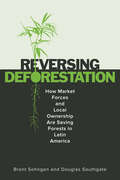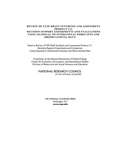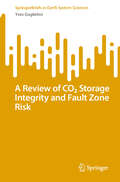- Table View
- List View
The Return of Collective Intelligence: Ancient Wisdom for a World out of Balance
by Dery DyerReveals how we can each reconnect to collective intelligence and return our world to wholeness, balance, and sanity • Explains how collective intelligence manifests in flocks of birds, instantaneous knowing in indigenous peoples, and the power of sacred places • Offers ways for us to reconnect to the infinite source of wisdom that fuels collective intelligence and underscores the importance of ceremony, pilgrimage, and initiation • Draws on recent findings in New Paradigm science, traditional teachings from indigenous groups from North, South, and Central America and Siberia, as well as sacred geometry, deep ecology, and expanded states of consciousness For our ancestors, collective intelligence was a normal part of life. We see it today as the mysterious force that enables flocks of birds, swarms of bees, and schools of fish to function together in perfect synchrony, communicating and cooperating at some undetectable level. At its most subtle, it&’s an instantaneous knowing, shared by members of a group, of the wisest course of action that will benefit all. As Dery Dyer reveals, collective intelligence still resides within each of us, and it is the key to restoring balance and harmony to our world. She shows how it occurs spontaneously when individuals who share a need and a purpose instinctively &“self-organize&” into a group and function with no leader or central authority. Such groups exhibit abilities much greater than what any of their members possess individually--or what can be replicated with artificial intelligence. Dyer explains, due to an unquestioning dependence on technology, modern humanity has forgotten how to connect with collective intelligence and fallen into collective stupidity, otherwise known as mob mind or groupthink, which is now endangering the interconnected web of life on Earth. Drawing on recent findings in New Paradigm science, traditional teachings from indigenous groups, as well as sacred geometry, deep ecology, and expanded states of consciousness, the author shows how the ability to think and act collectively for the highest good is hardwired in all living beings. She explains how to release ourselves from enslavement by technology and use it more wisely toward the betterment of all life. Underscoring the vital importance of ceremony, pilgrimage, and initiation, she offers ways for us to reconnect to the infinite source of wisdom that fuels collective intelligence and which manifests everywhere in the natural world. Revealing that once we relearn how to hear the Earth, we can heal the Earth, Dyer shows how each of us has a vital role to play in restoring our world to wholeness.
The Return of Nature: Sustaining Architecture in the Face of Sustainability
by Preston Scott Cohen Erika NaginskiThe Return of Nature asks you to critique your conception of nature and your approach to architectural sustainability and green design. What do the terms mean? Are they de facto design requirements? Or are they unintended design replacements? The book is divided into five parts giving you multiple viewpoints on the role of the relations between architecture, nature, technology, and culture. A detailed case study of a built project concludes each part to help you translate theory into practice. This holistic approach will allow you to formulate your own theory and to adjust your practice based on your findings. Will you provoke change, design architecture that responds to change, or both? Coedited by an architect and a historian, the book features new essays by Robert Levit, Catherine Ingraham, Sylvia Lavin, Barry Bergdoll, K. Michael Hays, Diane Lewis, Andrew Payne, Mark Jarzombek, Jean-Francois Chevrier, Elizabeth Diller, Antoine Picon, and Jorge Silvetti. Five case studies document the work of MOS Architects, Michael Bell Architecture, Steven Holl Architects, George L. Legendre, and Preston Scott Cohen.
The Return of the Horse
by Liz HuyckHorses began 55 million years ago in North America before migrating to Asia. One day, Europeans would bring horses back to the plains of North America.
The Return of the South Pole Sled Dogs: With Amundsen’s and Mawson’s Antarctic Expeditions
by Mary R. TahanThis book documents the return of the surviving sled dogs of the Norwegian Antarctic Expedition of 1910–1912 from Antarctica, where they had helped Roald Amundsen become the first human to reach the South Pole. This book is the sequel to the highly acclaimed Roald Amundsen’s Sled Dogs: The Sledge Dogs Who Helped Discover the South Pole. It chronicles how the sled dogs were used internationally to further promote the expedition’s great achievement and follows some of the dogs as they undertake subsequent expeditions – with Douglas Mawson’s Australasian Antarctic Expedition of 1911–1914, which made scientific discoveries, and with Arve Staxrud’s Norwegian Arctic Rescue Mission of 1913, which saved members of the Herbert Schröder-Stranz German Arctic Expedition. The book tracks the remaining 39 sled dogs to their next challenging adventures and their final destinations in Argentina, Norway, Antarctica, and Australia.Like its predecessor, the book portrays how Amundsen continued to utilize the Polar dogs – both in their lives and in their deaths – to propel his career and solidify his expedition's image.
The Return of the Unicorns: The Natural History and Conservation of the Greater One-Horned Rhinoceros (Biology and Resource Management Series)
by Eric DinersteinBeginning in 1984, Eric Dinerstein led a team directly responsible for the recovery of the greater one-horned rhinoceros in the Royal Chitwan National Park in Nepal, where the population had once declined to as few as 100 rhinos. The Return of the Unicorns is an account of what it takes to save endangered large mammals. In its pages, Dinerstein outlines the multifaceted recovery program—structured around targeted fieldwork and scientific research, effective protective measures, habitat planning and management, public-awareness campaigns, economic incentives to promote local guardianship, and bold, uncompromising leadership—that brought these extraordinary animals back from the brink of extinction. In an age when scientists must also become politicians, educators, fund-raisers, and activists to safeguard the subjects that they study, Dinerstein's inspiring story offers a successful model for large-mammal conservation that can be applied throughout Asia and across the globe.
Return of the Wild: 20 of Nature's Greatest Success Stories
by Helen ScalesDiscover the extraordinary ways nature has come back from the brink in this collection of 20 environmental success stories from around the world, written by Dr Helen Scales and beautifully illustrated by Good Wives and Warriors. From humpback whale populations thriving again in the freezing seas of Alaska and the recovery of kiwi populations in New Zealand, to the setting up of tiger sanctuaries and reserves in India and return of elephant seals from 'extinction', this book plants a message of hope and shows children that positive change is possible.As well as the 20 recovery stories, Return of the Wild teaches children about the different habitats that animals and plants around the world call home - oceans, forests, deserts and more - and introduces them to the real people supporting endangered species. Finishing off with small tips on what children at home can do to help the wild world, from wearing eco-friendly suncream while swimming in the sea to using less single use plastic, this book reassures children that there are many ways to protect and save our planet from environmental harm.
Return to Nature: The New Science of How Natural Landscapes Restore Us
by Emma LoeweDiscover the new science and ancient wisdom on why nature makes us healthier and happier in body and soul from the co-author of The Spirit Almanac and mindbodygreen’s Senior Sustainability Editor.For centuries, we have known that getting outside is good for us. Yet we have become increasingly disconnected from the earth that nourishes us, with most of us spending 87% of our days indoors. In response, writer and environmentalist Emma Loewe demonstrates the power of nature’s healing properties in a guidebook organized by eight landscapes. In each chapter, you'll find research-backed ways to explore that landscape right now and protect it in the future, so that it can be healthy and nurturing for generations to come. Drawing off modern science and innate wisdom, she uncovers: Why being by the ocean makes you measurably happierHow living near greenery helps you lives longerThe staggering, illuminating statistic that forests can make you more relaxed within 90 seconds of walking among trees.Alongside beautiful four-color illustrations that inspire us all to get outside in big and small ways, this stunning book—more urgent than ever—will appeal to anyone looking to connect with the world around them, whether in their neighborhood park or on a backpacking getaway.
Return to the Sky: The Surprising Story of How One Woman and Seven Eaglets Helped Restore the Bald Eagle
by null Tina Morris&“Three cheers for this splendid, surprising, inspiring book!&”—Sy Montgomery, author of The Soul of an OctopusAlone in a vast wildlife refuge with little direction and no experience, a Cornell Laboratory of Ornithology student found herself responsible for a project of historical importance—to bring the Bald Eagle back from near extinction.In Return to the Sky, Tina Morris, one of the first women to engage in a raptor reintroduction program, shares her remarkable story that is as much about the human spirit as it is about birds of prey.In the spring of 1975, on the eve of the US Bicentennial, Tina was selected to reintroduce Bald Eagles into New York State in the hope that the species could eventually repopulate eastern North America. Young and female in a male-dominated field, Tina was handed an assignment to rehabilitate a population that had been devastated by the effects of DDT. The challenges were prodigious—there was no model to emulate for a bird of the eagle&’s size, for one—but Tina soon found that her own path to self-discovery and confidence-building was deeply connected with the survival of the species she was chosen to protect.Ultimately, Tina spent two years playing &“mother&” to seven eaglets at Montezuma National Wildlife Refuge, east of Seneca Falls in New York. Driven by her passion, she discovered unknown reserves of patience, determination, and grit.At a time when the mass extinction of bird species is a critical global topic, Return to the Sky reminds us how, with a mix of common sense, resilience, and resolve, humans can be effective stewards of the natural world.&“Inspiring . . . [and] proof that one determined person can still make a difference. At a time when the mass extinction of bird species is a critically important global topic, Dr Morris reminds us that humans can still be effective guardians of the natural world.&”—Forbes&“Emotional and inspiring proof that one person can make a difference.&”—Kirkus Reviews&“Inspiring . . . the writing is clear and eloquent . . . Morris expertly blends moving memoir and scientific research in this remarkable and affecting story.&”—Booklist
Return to Wild America: A Yearlong Search for the Continent's Natural Soul
by Scott WeidensaulIn 1953, birding guru Roger Tory Peterson and noted British naturalist James Fisher set out on what became a legendary journey-a one hundred day trek over 30,000 miles around North America. They traveled from Newfoundland to Florida, deep into the heart of Mexico, through the Southwest, the Pacific Northwest, and into Alaska's Pribilof Islands. Two years later, Wild America, their classic account of the trip, was published. On the eve of that book's fiftieth anniversary, naturalist Scott Weidensaul retraces Peterson and Fisher's steps to tell the story of wild America today. How has the continent's natural landscape changed over the past fifty years? How have the wildlife, the rivers, and the rugged, untouched terrain fared? The journey takes Weidensaul to the coastal communities of Newfoundland, where he examines the devastating impact of the Atlantic cod fishery's collapse on the ecosystem; to Florida, where he charts the virtual extinction of the great wading bird colonies that Peterson and Fisher once documented; to the Mexican tropics of Xilitla, which have become a growing center of ecotourism since Fisher and Peterson's exposition. And perhaps most surprising of all, Weidensaul finds that much of what Peterson and Fisher discovered remains untouched by the industrial developments of the last fifty years. Poised to become a classic in its own right, Return to Wild America is a sweeping survey of the natural soul of North America today.
Returning North with the Spring
by John R HarrisAt winter's end in 1947, driven by the devastating loss of a son killed in World War II, naturalist Edwin Way Teale followed the dawning spring season northward in an amazing 17,000-mile odyssey from the Everglades to Maine. He wrote about the adventure in North with the Spring. Its sequel Wandering Through Winter won the Pulitzer Prize.Retracing Teale's route, writer John Harris reveals a vastly changed natural world. In Returning North with the Spring, he stops at the very places where Teale once stood, trekking through the Okefenokee wetland, the Great Smoky Mountains, the Great Dismal Swamp, the New Jersey Pine Barrens, and Cape Cod. He is stunned to see how climate change, invasive species, and other factors have affected the landscapes and wildlife. Yet he also discovers that many of the sites Teale described have been newly "rewilded" or permanently protected by the government.Homage to the past, report on the present, glimpse into the future--this book honors what has been lost in the years since Teale's famous journey and finds hope in the small tenacities of nature.
Reuniting Economy and Ecology in Sustainable Development (Sustainable Community Development Ser. #7)
by Charles R. BeatonReuniting Economy and Ecology in Sustainable Development is part of a series on the various aspects of sustainable development, where "community" focuses on the primacy and quality of relationships among people sharing a particular place and between people and their environment. "Development" means personal and social transformation to a higher level of consciousness and a greater responsibility to be one anothers keepers, and "sustainability" is the act whereby one generation saves options by passing them to the next generation, which saves options by passing them onto the next and so on. The vision put forth in this book is one of melding ecology and economy into a unifying concept of social-environmental sustainability. The author suggests that dividing ecology and economy conceptually will destroy society as we know it. Our task as adults is to repair the environment for the children who must inherit it.The link between economics and ecology and the immense potential of that connection to influence the process of change within communities is the focus of this book. The authors theorize that in a healthy, future-oriented community there is a dominant role for sustainability. Each of these four concepts - economics, ecology, community and sustainability - are intimidating on their own. There has been volumes written on each topic separately but very little written on how they are connected in relation to the environment. Reuniting Economy and Ecology makes those connections and provides a base for finding solutions to achieving sustainable communities.
Reuse It! (Saving Our Planet)
by Mary BooneIntroduces early readers to environmentalist concepts including single-use plastics and upcycling, and what they can do to help the environment. Real-life examples of kids who have made a difference are featured.
Reuse of Materials and Byproducts in Construction
by Alan RichardsonThe construction industry is the largest single waste producing industry in the UK. Ensuring a supply chain of recycled materials affords many potential gains, achieved through: reducing the material volume transported to already over-burdened landfill sites, possible cost reductions to the contractor/client when considering the landfill tax saved and the potential for lower cost material replacements, a reduction in the environmental impact of quarrying and the saving of depleting natural material resources. Reuse of Materials and Byproducts in Construction: Waste Minimization and Recycling addresses use of waste and by products in the construction industry. An over view of new "green" design guides to encourage best practice will be examined and current legislation that channels on site practices, such as site waste management plans. Fundamental individual construction materials are discussed and the process of reforming by products and waste products into new construction materials is investigated, examining the material performance, energy required to convert waste into new products and viability of recycling. The main range of constructional materials will be examined. Aimed at postgraduate students, lecturers and researchers in construction and civil engineering, the book will also be of interest to professional design practices.
Reusing Things (Making a Difference)
by Sue BarracloughDiscover how to make a difference to the planet by reusing things, reducing garbage, recycling materials, and respecting our world. Find out how you can play an active part, from repairing things, to giving unwanted items away.
The Revaluation of Women's Work (Environmental and Resource Economics Set)
by Sheila LewenhakThis book provides a survey and analysis of the different ways in which women's work is valued throughout the world. It challenges the narrow definition of work as paid work, as that excludes so many of women's activities. It looks at ways in which women's worth has been consistently undervalued in industrial as well as non-industrial countries, in socialist as well as free-enterprise economies. These practices distort the national product of countries heavily dependent on women's labour, but, above all, they are among the most obvious marks of the exploitation of women. Technological changes are already altering established female/male divisions of labour. Transnational enterprises, often located in Special Economic Zones, are reducing differences between industrial and nonindustrial countries. Valuing women's work correctly, whether unpaid in the home or underpaid outside it, is part of the battle against discrimination and poverty. Men who do similar work also benefit. It is the crucial step towards the achievement of male/female equality. The book will be particularly valuable for those concerned with the issues, in trade unions, women's groups, international agencies and NGOs and for course in economics and social studies.
Revaluing Horticultural Skills: The Knowledge and Labour of Growing Food (Critical Food Studies)
by Hannah PittThis book highlights the value and skill of horticultural work through stories of food cultivation. It examines the difficulties that arise from the perception that this type of activity is unskilled and the importance of acknowledging the expertise involved in growing food.The book provides a rare focus on horticulture as a vital part of agri-food systems, offering a social science perspective on the sector’s current and past characteristics. It presents new primary research into horticultural work and workers across UK food growing, using close attention to their abilities to highlight the depth of their knowledge and learning. This is set in the context of global agri-food regimes which press producers to seek ever more precarious labour, undermining food justice. By examining these in the context of internationally connected supply chains, it characterises injustices which recur globally and across food system labour. The conceptual argument starts from an ecological definition of skill as a social practice embedded within its socio-economic landscape, developing this perspective beyond its association with artisanal contexts. Together the empirical and conceptual materials highlight the fallacy of discourse which tends to individualise skill and the challenges around recruitment into food production. To counter this, the book proposes a more collective approach to fostering healthy skills ecosystems, reaching towards commoning through examples of horticultural communities seeking this in the meantime.It will appeal to postgraduates, researchers and professionals interested in food systems, their workers and related topics of horticultural education, training and human resources, labour, migration and politics of injustice. It draws on perspectives from rural studies, human geography and sociology and connects with international debates in these fields. Food focused scholars and activists will find data and insights to support calls for better work in food systems.
Revealing the Invisible Mine: Social Complexities of an Undeveloped Mining Project (Pacific Perspectives: Studies of the European Society for Oceanists #8)
by Emilia SkrzypekExploring the social complexities of the Frieda River Project in Papua New Guinea, this book tells the story of local stakeholder strategies on the eve of industrial development, told largely from the perspective of the Paiyamo - one of the project’s so-called ‘impact communities’. Engaging ideas of knowledge, belief and personhood, it explains how fifty years of encounters with exploration companies shaped the Paiyamo’s aspirations, made them revisit and re-examine their past, and develop new strategies to move towards a better, more prosperous future.
Revenant Ecologies: Defying the Violence of Extinction and Conservation
by Audra MitchellEngaging a broad spectrum of ecological thought to articulate the ethical scale of global extinction As global rates of plant and animal extinctions mount, anxieties about the future of the earth&’s ecosystems are fueling ever more ambitious efforts at conservation, which draw on Western scientific principles to manage species and biodiversity. In Revenant Ecologies, Audra Mitchell argues that these responses not only ignore but also magnify powerful forms of structural violence like colonialism, racism, genocide, extractivism, ableism, and heteronormativity, ultimately contributing to the destruction of unique life forms and ecosystems. Critiquing the Western discourse of global extinction and biodiversity through the lens of diverse Indigenous philosophies and other marginalized knowledge systems, Revenant Ecologies promotes new ways of articulating the ethical enormity of global extinction. Mitchell offers an ambitious framework—(bio)plurality—that focuses on nurturing unique, irreplaceable worlds, relations, and ecosystems, aiming to transform global ecological–political relations, including through processes of land return and critically confronting discourses on &“human extinction.&” Highlighting the deep violence that underpins ideas of &“extinction,&” &“conservation,&” and &“biodiversity,&” Revenant Ecologies fuses political ecology, global ethics, and violence studies to offer concrete, practical alternatives. It also foregrounds the ways that multi-life-form worlds are actively defying the forms of violence that drive extinction—and that shape global efforts to manage it. Retail e-book files for this title are screen-reader friendly with images accompanied by short alt text and/or extended descriptions.
The Revenge of Geography: What the Map Tells Us About Coming Conflicts and the Battle Against Fate
by Robert D. KaplanIn this provocative, startling book, Robert D. Kaplan, the bestselling author of Monsoon and Balkan Ghosts, offers a revelatory new prism through which to view global upheavals and to understand what lies ahead for continents and countries around the world. In The Revenge of Geography, Kaplan builds on the insights, discoveries, and theories of great geographers and geopolitical thinkers of the near and distant past to look back at critical pivots in history and then to look forward at the evolving global scene. Kaplan traces the history of the world's hot spots by examining their climates, topographies, and proximities to other embattled lands. The Russian steppe's pitiless climate and limited vegetation bred hard and cruel men bent on destruction, for example, while Nazi geopoliticians distorted geopolitics entirely, calculating that space on the globe used by the British Empire and the Soviet Union could be swallowed by a greater German homeland. Kaplan then applies the lessons learned to the present crises in Europe, Russia, China, the Indian subcontinent, Turkey, Iran, and the Arab Middle East. The result is a holistic interpretation of the next cycle of conflict throughout Eurasia. Remarkably, the future can be understood in the context of temperature, land allotment, and other physical certainties: China, able to feed only 23 percent of its people from land that is only 7 percent arable, has sought energy, minerals, and metals from such brutal regimes as Burma, Iran, and Zimbabwe, putting it in moral conflict with the United States. Afghanistan's porous borders will keep it the principal invasion route into India, and a vital rear base for Pakistan, India's main enemy. Iran will exploit the advantage of being the only country that straddles both energy-producing areas of the Persian Gulf and the Caspian Sea. Finally, Kaplan posits that the United States might rue engaging in far-flung conflicts with Iraq and Afghanistan rather than tending to its direct neighbor Mexico, which is on the verge of becoming a semifailed state due to drug cartel carnage. A brilliant rebuttal to thinkers who suggest that globalism will trump geography, this indispensable work shows how timeless truths and natural facts can help prevent this century's looming cataclysms.Advance praise for The Revenge of Geography "Robert D. Kaplan wields geography like a scalpel, using it to examine international relations and conflicts that globalization fails to explain. The Revenge of Geography is a sagacious account of how geography has shaped the world we know--and what this means for the future. Kaplan's wedding of historical and present-day analysis on a region-by-region basis makes for a well-researched, entertaining, and informative read that cannot be ignored."--Ian Bremmer, president of Eurasia Group and author of Every Nation for Itself "The importance of geography in shaping history is the great issue that Robert Kaplan tackles in this extraordinary book. Thirty years of scholarship and travel lie behind his recounting of human triumphs and conflicts through the ages. At the heart of his wide-ranging analysis is his belief in the abiding influence of geography on human behavior, now and in the future."--James Hoge, counselor, Council on Foreign RelationsFrom the Hardcover edition.
Reversing Deforestation: How Market Forces and Local Ownership Are Saving Forests in Latin America
by Brent Sohngen Douglas SouthgateDire reports of surging deforestation in the Brazilian Amazon appear often in international headlines, with commentators decrying the destruction of tree-covered habitats as an act of environmental vandalism. Although forest losses are alarming, broader trends are bending in the direction of forest recovery. In this book, Brent Sohngen and Douglas Southgate address the long-term recovery of forests in Latin America. The authors synthesize trends in demography, agricultural development, and technological change, and argue that slower population growth and increasing crop and tree yields—in conjunction with protecting local ownership of natural resources—have encouraged forest transition. This book explores how market forces, ownership arrangements, and the enforcement of property rights have influenced this shift from net deforestation to net afforestation. Forest transitions have happened before, such as the recovery of tree-covered habitats in Europe and the United States. Signs of a similar transformation in land use are now present in Latin America. Ending deforestation requires a strengthening of forest dwellers' property rights while ensuring that biodiversity conservation is no longer treated as a value-less externality. The resulting forest landscape, actively managed for ecosystem services, will be more resilient, as is needed to overcome climate change.
Review Criteria for Successful Treatment of Hydrolysate at the Blue Grass Chemical Agent Destruction Pilot Plant
by Committee on Review Criteria for Successful Treatment of Hydrolysate at the Pueblo Blue Grass Chemical Agent Destruction Pilot PlantsIn 1993, the United States signed the Chemical Weapons Convention (CWC), an international treaty outlawing the production, stockpiling, and use of chemical weapons. The chemical weapons stockpiles at five of the U. S. chemical weapons storage sites have now been destroyed. At those sites, the munitions were robotically opened and the chemical agent was removed, collected, and incinerated. One of the remaining sites with chemical weapons stockpiles is the Blue Grass Army Depot near Richmond, Kentucky. In this case, caustic hydrolysis will be used to destroy the agents and energetics, resulting in a secondary waste stream known as hydrolysate. "Review Criteria for Successful Treatment of Hydrolysate at the Blue Grass Chemical Agent Destruction Pilot Plant" develops criteria for successfully treating the hydrolysate, identifies systemization data that should factor into the criteria/decision process, suggests potential modifications to suggested treatment that would allow continued onsite processing, and assesses waste disposal procedures. This study further examines the possibility of delay or failure of the existing technology and examines possible alternatives to onsite treatment.
Review Of Ccsp Draft Synthesis And Assessment Product 5.3: Decision-support Experiments And Evaluations Using Seasonal To Interannual Forecasts And Observational Data
by National Research Council of the National AcademiesThis study offered an independent peer review for a synthetic document being produced for the CCSP. It found the draft document to be in a fairly early stage of development and noted several issues needing attention in the revision. The draft was inconsistent across sections with respect to whether or not it accepted two assumptions: that more skillful forecasts necessarily have greater value, and that the most useful form of information is a projected future value of an outcome parameter with an uncertainty distribution. Available scientific evidence gives reason to question these assumptions, and the draft did not discuss the evidence. Among other issues needing attention, the review called for the revised draft to do more to substantiate its claims of the potential benefits of knowledge-action networks and to give more careful consideration to the appropriate balance of roles between governmental and private efforts.
Review of Closure Plans for the Baseline Incineration Chemical Agent Disposal Facilities
by National Research Council of the National AcademiesThis book responds to a request by the director of the U.S. Army Chemical Materials Agency (CMA) for the National Research Council to examine and evaluate the ongoing planning for closure of the four currently operational baseline incineration chemical agent disposal facilities and the closure of a related testing facility. The book evaluates the closure planning process as well as some aspects of closure operations that are taking place while the facilities are still disposing of agent. These facilities are located in Anniston, Alabama; Pine Bluff, Arkansas; Tooele, Utah; and Umatilla, Oregon. They are designated by the acronyms ANCDF, PBCDF, TOCDF, and UMCDF, respectively. Although the facilities all use the same technology and are in many ways identical, each has a particular set of challenges.
A Review of CO₂ Storage Integrity and Fault Zone Risk (SpringerBriefs in Earth System Sciences)
by Yves GuglielmiThis book compares how seismic fault activation can be described by frictional-based theories such as the rate and state theory or by a general dynamic plasticity approach such as the Cam-Clay theory. In this book, the leading edge of fault physics concepts that are best suited and applicable to assess the risk of leakage and induced seismicity associated with large-scale CO₂ storage in sedimentary basins are explored. It compares the hydromechanical response of faults under deviatoric loading at laboratory, field experiment and basin scales. A review of some key parameters that drive the brittle-ductile behavior of faults affecting the reservoir-caprock system is presented. It is suggested that more general plastic criteria than the Coulomb failure should be used to better account for the ratio between the bulk plasticity and localized frictional strength of a fault zone. Based on new field data, it is shown that most of the fault permeability increase occurs at the onset of activation due to bulk dilation, whereas shearing has less impact on the permeability. This is different from laboratory observations where shearing often results in strong permeability reductions. This last part leads to some new concepts that have not been discussed to date, such as the possibility of slow fault movements eventually evolving to earthquakes at timescales of years to decades, thus relevant to the time life of CO₂ storage permits.
Review Of Earthscope Integrated Science
by Committee on the Review of EarthScope Science Objectives Implementation PlanningThe National Academies Press (NAP)--publisher for the National Academies--publishes more than 200 books a year offering the most authoritative views, definitive information, and groundbreaking recommendations on a wide range of topics in science, engineering, and health. Our books are unique in that they are authored by the nation's leading experts in every scientific field.
